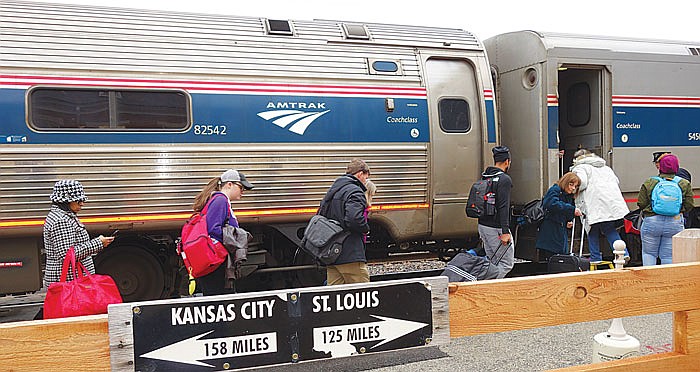Two issues have affected ridership on the Missouri River Runner Amtrak service over the past 20 years - gas prices and construction.
"If gas prices get high, our ridership goes up," said Kristi Jamison, Missouri Department of Transportation (MoDOT) railroad operations manager. "If they get low, our ridership goes down.
"The same can be said when we have had construction projects on the line. The work affects on-time performance, and people want to be to their destinations on time and not having to be bused as part of their trip. When the work is completed, the trains get back on schedule and the people start riding the trains again."
MoDOT reported in December that Amtrak ridership was down for fiscal year 2016, at 7.3 percent less than 2015 numbers.
Passenger numbers for the Jefferson City station have stayed fairly consistent, according to figures provided by Amtrak. Although there has been a drop in ridership from 2013-16, Jamison said it mirrors the low gas prices seen during that time.
"This has also been a period where construction has affected on-time performance," she said. "When you go below 70 percent, that affects ridership. Thirty percent of the traffic we have on the River Runner are passengers making connections in either St. Louis or Kansas City. So when you have delays like, what we've seen in construction of the high-speed rail service in Illinois, that drops the ridership level.
The Missouri River Runner travels between St. Louis and Kansas City, stopping in Jefferson City.
"The good news is the project should be completed this year, and we hope the 110-mph service will make people want to ride. When you compare the month numbers, we came real close to meeting or exceeding the same numbers we had the last few months, compared to the same time in 2015."
Despite construction delays, on-time performance went up - from 83 percent in 2015 to 86 percent in 2016. For December, the figure rose to 94 percent.
"The customer satisfaction surveys on the River Runner are getting good marks, too," Jamison added. "In 2015, we had 87 percent very satisfied, and in 2016 we went up to 90 percent. In the last four years, the route has been in the top five for rider satisfaction and in the top 10 even longer. The on-time performance drives that."
Funding for the two cross-state trains comes from the state Legislature. In 2015, $8.9 million was appropriated, and in 2016 it was $9.6 million. MoDOT requested $11.4 million for fiscal year 2017; Gov. Jay Nixon had $10.1 million in his budget, which is back down to $9.6 million as proposed by lawmakers for approval during the legislative session. The budget request for the service in fiscal year 2018 is $14.1 million.
"We've been fortunate to see the funding we've had," Jamison said. "Back in 2007, the University of Missouri did a study on the corridor to identify where the bottlenecks were, and that guided us as we put to together applications for funding projects like the second Osage River bridge. But the biggest bottleneck, according to the MU study, was around California. Guided by that, the General Assembly for the first time funded a rail-improvement project, which was a long siding track to allow freight trains to wait while the passenger trains went through. Once the work was done, you saw a significant rise in on-time performance, and ridership also went up."
Jamison said 10-15 years ago a lot more freight went through on the Union Pacific lines the River Runner trains use.
"There's still a lot of coal going through, but in the last few years that has dwindled quite a bit," she said.
"There still can be congestion when trains have to be rerouted for various reasons, but overall the freight traffic volume hasn't been an issue lately for passenger trains to reach their destinations on time."

